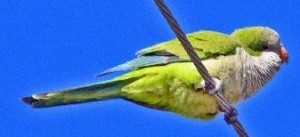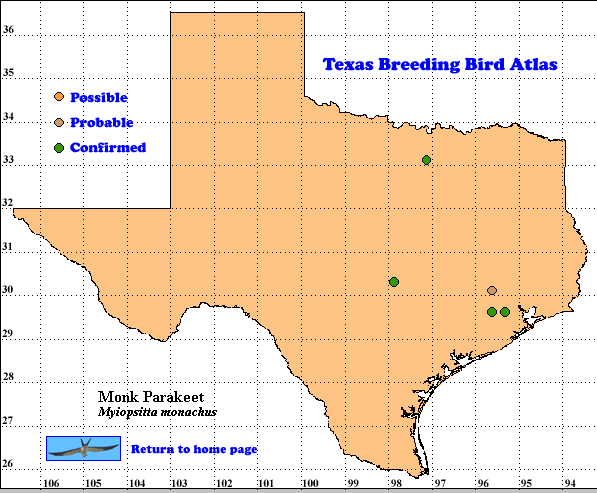The Monk Parakeet is a chunky parrot with a long tail .Its total length is 28-30 cm (11-12 in)). It is green above with a gray face and breast, a buffy belly and a green tail. The large, conspicuous stick-nest built by this species gives it an ecological advantage over other parrots, which must find natural or artificial cavities. The structures, which may contain nests for up to 12 pairs, are used for roosting at night as well as for breeding are often repaired before each breeding season (Spreyer and Bucher 1998). Its size makes it easy for birdwatchers and atlasers to find this species at any time of the day.
DISTRIBUTION: The Monk Parakeet’s native range extends from southern Brazil and Bolivia to central Argentina, below 1000 m (3300 ft) elevation (Forshaw 1977, Spreyer and Bucher 1998).It was introduced into the United States in great numbers in the 1960s for the pet trade, mostly in the northeast. Two Monk Parakeets were reported in Texas in 1973-1975. Monk Parakeets were thought to be rapidly expanding their range with news accounts of 4000-5000 in the U. S. The birds were perceived as a danger to agriculture. Thirteen northeast states organized to eradicate them. The work was coordinated by the Damage Control Section of the U. S. Fish and Wildlife Service. During the period 1970-1976, they only found 367 Monk Parakeets and 163 were removed. It seemed Monk Parakeets were not going to turn into European Starlings (Sturnus vulgaris) after all, and controls were discontinued (Neidermyer and Hickey 1977).
From the Breeding Bird Atlas data and other surveys, we have learned there are Monk Parakeet colonies in the southwest suburbs of Austin (latilong 30097), in the southwest suburbs of Houston (29093), and on the transmission towers over Expressway 146 near Kemah, Texas (29095-E1). Small flocks and/or single Monk Parakeets have also been seen in Galveston (29094), Montgomery (30095), Llano (30098), Tarrant (32097) and Hookley (32102) counties.
SEASONAL OCCURRENCE: The Monk Parakeet occupies its stick nest the year around and generally does not wander far from it. These parakeets are sometimes seen in winter roosts of grackles. Egg laying in North America generally occurs from April to July and a second clutch may be laid in early September. In Argentina, the usual clutch is 5-8 eggs which are incubated for 24 days. Young birds start leaving the nest at about 49 days after hatching and most remain with their parents until about 3 months old (Spreyer and Bucher 1998).
BREEDING HABITAT. The Monk Parakeet is an urban dweller. It feeds on fruit and grains that occur in the suburbs and wetlands. It builds its communal roost and breeding nest out of green, thorny sticks and other materials, attached to utility structures, high signs and tall trees. One nest measuring 1.2 by 2 m (4×6 ft)), contained seven compartments and housed 13 Monk Parakeets (Neidermyer and Hickey 1977). Most nests are smaller. These birds often nest along small streams and other wetlands. Water pumping stations are a favorite site.
STATUS: The Monk Parakeet is an introduced exotic. It is not widespread in Texas, but is locally common and slow to expand away from its stick nest colony into new territories.
In the early 21st century, it is very locally common in some metropolitan areas in Texas. Most colonies are descended from escaped cage birds, but some were deliberately released in Austin in the 1980s (Lockwood and Freeman 2004). The survival of Monk Parakeets in Texas may be dependent on the supply of bird seed in feeders , as is the case in some northern states, such as Illinois where winter feeding has been studied (Spreyer and Bucher 1998).
Text by Harold H. Burgess (Posted with updates 2006)
Literature cited.
Forshaw, J. M. 1977. Parrots of the world. Doubleday, New York.
Lockwood, M. W. and B. Freeman. 2004. The TOS handbook of Texas birds. Texas A&M University Press, College Station.
Neidermyer, W. J. and J. J. Hickey. 1977. The Monk Parakeet in the United States, 1970-75. Am. Birds 31: 273-278.
Spreyer, M. F. and E. H. Bucher. 1998. Monk Parakeet (Myiopsitta monachus). In The birds of North America, No. 322 (A. Poole and F. Gill, eds.). The Birds of North America, Inc., Philadelphia, PA.

